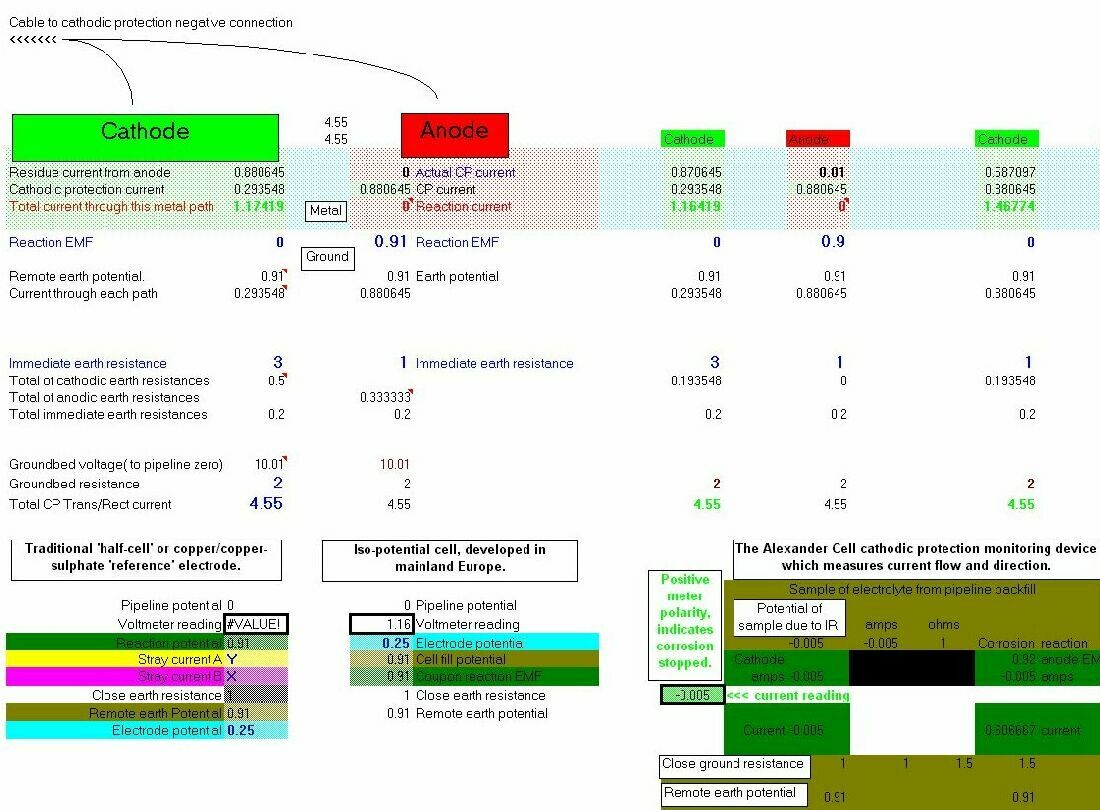
Cathodic Protection Study 7
WHAT CAN BE DONE?
This problem has been overcome in two ways:-
1. A device has been developed (by Dr. Prinz of Rhurgas, Germany), which makes it
possible to measure interface potentials in relation to a sample (coupon) of metal
attached to the pipeline.
2. Another device (The Alexander Cell) makes it possible to measure the current of a
corrosion cell attached to the pipeline.
SPREAD SHEET CPSTUDY7.XLS
This spread sheet shows the reaction of the three methods of measuring the voltages which
allow us to judge whether cathodic protection is complete.

1. It can be seen that we cannot make a judgement based on the traditional half-cell
method as there are too many variables in the measuring circuit to allow mathmatical or computerised analysis of the readings.
2. The measuring system suggested in continental Europe still begs the question of
what criteria can be used, as the actual field results from this system have not
always suggested the observed condition of the pipeline metal on excavation.
3. The spreadsheet model of the Alexander Cell works in the same way as it does in the
field and results have always proved correct on excavation.
ACTION
1. TRAINING
Staff should be trained in the new measuring techniques which are shown on worksheet
CPSTUDY7.XLS. It will be seen that they give a coherent measurement which is not possible
with the 'half-cell' alone. The training should be
conducted with sufficient field work to confirm the new
concepts.
2. REVISED ACTIVITIES
Retrained staff can then be utilised to revise all cathodic protection work. This will result in cutting the cost of monitoring activities.
3. COMPUTERISATION AND UPGRADE
All records should be computerised, during which activity the staff will be able to apply new
principles to analyse the readings. Computer models can be tailored to store and access the
information direct from the field operator following formal procedures to standardise the input.
Operator errors will be highlighted by the computer as soon as the entry is made and this will
identify areas that are in need of attention.
4. CONDITION MONITORING
It is possible to identify (to within 100mm) a coating fault and predict the condition of the pipe
metal with 95% accuracy. (Experience has shown that surveys based on traditional concepts
have a less than 20% chance of accuracy.)
Condition monitoring, based on the concepts of the CPN, can enhance the results of 'intelligent
pigging' by determining the remedial measures which will prevent further metal loss.
5. INSPECTION AND CONTROL
Proper inspection and control of cathodic protection activities can reduce costs by an order of
magnitude. The introduction of video inspection can control the field activities while
computerised organisation can maintain control of all outlay and monitor the performance on
a daily basis.
Return to main page


